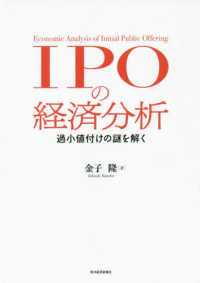- ホーム
- > 洋書
- > 英文書
- > Science / Mathematics
基本説明
With the first edition considered the primary reference on geostatistics, the new edition promises to maintain the same thorough but comprehensible blend of theoretical background and statistical application.
Full Description
Praise for the First Edition
". . . a readable, comprehensive volume that . . . belongs on the desk, close at hand, of any serious researcher or practitioner." —Mathematical Geosciences
The state of the art in geostatistics
Geostatistical models and techniques such as kriging and stochastic multi-realizations exploit spatial correlations to evaluate natural resources, help optimize their development, and address environmental issues related to air and water quality, soil pollution, and forestry. Geostatistics: Modeling Spatial Uncertainty, Second Edition presents a comprehensive, up-to-date reference on the topic, now featuring the latest developments in the field.
The authors explain both the theory and applications of geostatistics through a unified treatment that emphasizes methodology. Key topics that are the foundation of geostatistics are explored in-depth, including stationary and nonstationary models; linear and nonlinear methods; change of support; multivariate approaches; and conditional simulations. The Second Edition highlights the growing number of applications of geostatistical methods and discusses three key areas of growth in the field:
New results and methods, including kriging very large datasets; kriging with outliers; nonse??parable space-time covariances; multipoint simulations; pluri-gaussian simulations; gradual deformation; and extreme value geostatistics
Newly formed connections between geostatistics and other approaches such as radial basis functions, Gaussian Markov random fields, and data assimilation
New perspectives on topics such as collocated cokriging, kriging with an external drift, discrete Gaussian change-of-support models, and simulation algorithms
Geostatistics, Second Edition is an excellent book for courses on the topic at the graduate level. It also serves as an invaluable reference for earth scientists, mining and petroleum engineers, geophysicists, and environmental statisticians who collect and analyze data in their everyday work.
Contents
Preface to the Second Edition ix
Preface to the First Edition xiii
Abbreviations xv
Introduction 1
Types of Problems Considered 2
Description or Interpretation? 8
1. Preliminaries 11
1.1 Random Functions 11
1.2 On the Objectivity of Probabilistic Statements 22
1.3 Transitive Theory 24
2. Structural Analysis 28
2.1 General Principles 28
2.2 Variogram Cloud and Sample Variogram 33
2.3 Mathematical Properties of the Variogram 59
2.4 Regularization and Nugget Effect 78
2.5 Variogram Models 84
2.6 Fitting a Variogram Model 109
2.7 Variography in the Presence of a Drift 122
2.8 Simple Applications of the Variogram 130
2.9 Complements: Theory of Variogram Estimation and Fluctuation 138
3. Kriging 147
3.1 Introduction 147
3.2 Notations and Assumptions 149
3.3 Kriging with a Known Mean 150
3.4 Kriging with an Unknown Mean 161
3.5 Estimation of a Spatial Average 196
3.6 Selection of a Kriging Neighborhood 204
3.7 Measurement Errors and Outliers 216
3.8 Case Study: The Channel Tunnel 225
3.9 Kriging Under Inequality Constraints 232
4. Intrinsic Model of Order k 238
4.1 Introduction 238
4.2 A Second Look at the Model of Universal Kriging 240
4.3 Allowable Linear Combinations of Order k 245
4.4 Intrinsic Random Functions of Order k 252
4.5 Generalized Covariance Functions 257
4.6 Estimation in the IRF Model 269
4.7 Generalized Variogram 281
4.8 Automatic Structure Identification 286
4.9 Stochastic Differential Equations 294
5. Multivariate Methods 299
5.1 Introduction 299
5.2 Notations and Assumptions 300
5.3 Simple Cokriging 302
5.4 Universal Cokriging 305
5.5 Derivative Information 320
5.6 Multivariate Random Functions 330
5.7 Shortcuts 360
5.8 Space Time Models 370
6. Nonlinear Methods 386
6.1 Introduction 386
6.2 Global Point Distribution 387
6.3 Local Point Distribution: Simple Methods 392
6.4 Local Estimation by Disjunctive Kriging 401
6.5 Selectivity and Support Effect 433
6.6 Multi-Gaussian Change-of-Support Model 445
6.7 Affine Correction 448
6.8 Discrete Gaussian Model 449
6.9 Non-Gaussian Isofactorial Change-of-Support Models 466
6.10 Applications and Discussion 469
6.11 Change of Support by the Maximum (C. Lantuéjoul) 470
7. Conditional Simulations 478
7.1 Introduction and Definitions 478
7.2 Direct Conditional Simulation of a Continuous Variable 489
7.3 Conditioning by Kriging 495
7.4 Turning Bands 502
7.5 Nonconditional Simulation of a Continuous Variable 508
7.6 Simulation of a Categorical Variable 546
7.7 Object-Based Simulations: Boolean Models 574
7.8 Beyond Standard Conditioning 590
7.9 Additional Topics 606
7.10 Case Studies 615
Appendix 629
References 642
Index 689







